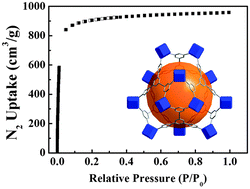A highly porous NbO type metal–organic framework constructed from an expanded tetracarboxylate†
Abstract
A novel NbO type microporous metal–organic framework Cu2L (ZJU-32; H4L = 5′-((3,5-dicarboxyphenyl)ethynyl)-[1,1′:3′,1′′-terphenyl]-4,4′′-dicarboxylic acid) constructed from an elaborately designed tetratopic ligand was solvothermally synthesized and structurally characterized. The activated ZJU-32a exhibits high permanent porosity with the Brunauer–Emmett–Teller (BET) surface area of 3831 m2 g−1 and the pore volume of 1.482 cm3 g−1, enabling it to be a promising material for both methane storage and carbon dioxide capture at room temperature.


 Please wait while we load your content...
Please wait while we load your content...